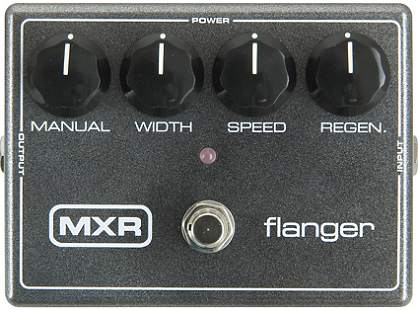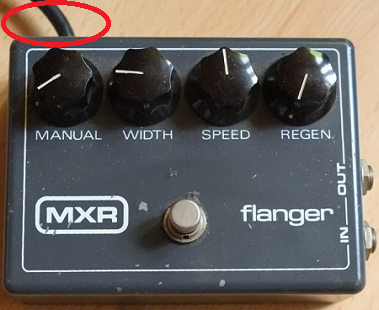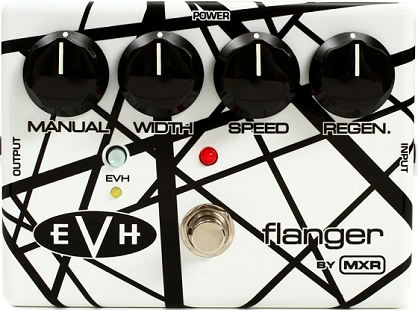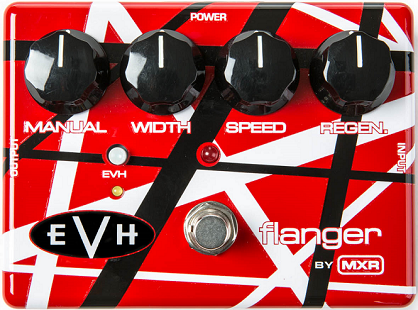Difference between revisions of "M117R Flanger"
| Line 2: | Line 2: | ||
| __TOC__ | | __TOC__ | ||
|} | |} | ||
| − | The [[Dunlop / MXR|MXR]] M117R Flanger. This is a flanger that you've heard on all kinds of recordings | + | The [[Dunlop / MXR|MXR]] M117R Flanger. This is a flanger that you've undoubtedly heard on all kinds of recordings - you just couldn't recognize it. The person who really made the MXR Flanger famous was [[Eddie Van Halen]]. This effect can be and has been used, not just in heavy music, but across all kinds of different music genres. Unlike the impression that the famous EVH "Swoosh" probably gives when you first hear it, the M117R Flanger is an effect pedal that can also be used very subtly and tastefully. When you learn about all that the pedal can do, it's actually a pretty remarkable little effect. The design and execution are definitely inspired. |
| − | If you've followed our site for any length of time, you're probably aware that we do not hold artist-editions | + | If you've followed our site for any length of time, you're probably also aware that we do not hold artist-editions of musical equipment in higher esteem than standard work-a-day instruments and equipment. We think it's important to point out that our favorite, and your favorite artists only got limited-artist-signature-edition equipment AFTER they became famous. Everything they did to get famous was most likely standard version equipment that they played or that they tweaked-and-then-played themselves. |
| − | ...Then again, we're also just human beings. In rare instances, we've been known to defy our better judgment. Our resolve will sometimes soften... and we'll consider grabbing a limited edition. But the rare occasions this happens are if and only if we're able to find an exceptionally good deal. In our own personal gear collections, you'll mostly find us using "vanilla" equipment, including the M117R. | + | ...Then again, despite the friendly finger-wagging, we're also just human beings. In rare instances, we've been known to defy our better judgment. Our resolve will sometimes soften... and we'll consider grabbing a limited edition. But the rare occasions this happens are if and only if we're able to find an exceptionally good deal. In our own personal gear collections, you'll mostly find us using "vanilla" equipment, including the M117R. |
| Line 32: | Line 32: | ||
==General Information== | ==General Information== | ||
| − | The original MXR Flanger was released in 1978. One of the bigger | + | The original MXR Flanger was first released in 1978. One of the bigger features that made it attractive was the built-in AC power cord (seen below, circled in red). Now, while Boss had also used AC power in the form of an AC adapter for their BF-1 Flanger, MXR took a different tack. While the attached power cord may have telegraphed to artists that the MXR Flanger would be a boon for them (no batteries to chew up), MXR's engineers embraced the tangent: because their flanger drew AC current from a standard wall outlet, they would also be free to design a much higher headroom flanger effect. Most other flangers, Boss's BF-1 for example, may have also been designed to use only an AC adapter, but Boss then also decided to use only 9-volts. Such decisions prevented these competitors from offering similarly lush flanger effects. |
| + | |||
| + | Interestingly,[[Electro-Harmonix]], like MXR, also decided that it was preferable for their Electric Mistress flanger to use higher power in order to have higher headroom, and a lusher sound. | ||
[[File:MXR_M117Flanger_Vintage.png|center|frame|<div style="text-align:right">Image of vintage MXR Flanger from [https://en.audiofanzine.com/guitar-flanger/mxr/m117-flanger-vintage/medias/pictures/#id:1516770 AudioFanzine.com] <br /> Copyright of image not found. Presumed Public Domain.</div>]] | [[File:MXR_M117Flanger_Vintage.png|center|frame|<div style="text-align:right">Image of vintage MXR Flanger from [https://en.audiofanzine.com/guitar-flanger/mxr/m117-flanger-vintage/medias/pictures/#id:1516770 AudioFanzine.com] <br /> Copyright of image not found. Presumed Public Domain.</div>]] | ||
| − | The modern retooled version, the M117R, attempts to carry on | + | The modern retooled version, the M117R, attempts to carry on the tradition of high headroom (at least somewhat) with under-side access for two 9-volt batteries, and a jack for an 18-volt AC power adapter at the top. |
Vintage versions of the original MXR Flanger can still be found for what we believe are ("now", 2018) "reasonable" prices. They're especially "reasonable" when compared to the prices for vintage Electro-Harmonix Electric Mistress flangers. That said, we don't happen to believe that vintage MXR Flangers sound so much better than the newer reissues that it's worth bothering about. | Vintage versions of the original MXR Flanger can still be found for what we believe are ("now", 2018) "reasonable" prices. They're especially "reasonable" when compared to the prices for vintage Electro-Harmonix Electric Mistress flangers. That said, we don't happen to believe that vintage MXR Flangers sound so much better than the newer reissues that it's worth bothering about. | ||
Revision as of 08:04, 9 October 2018
The MXR M117R Flanger. This is a flanger that you've undoubtedly heard on all kinds of recordings - you just couldn't recognize it. The person who really made the MXR Flanger famous was Eddie Van Halen. This effect can be and has been used, not just in heavy music, but across all kinds of different music genres. Unlike the impression that the famous EVH "Swoosh" probably gives when you first hear it, the M117R Flanger is an effect pedal that can also be used very subtly and tastefully. When you learn about all that the pedal can do, it's actually a pretty remarkable little effect. The design and execution are definitely inspired.
If you've followed our site for any length of time, you're probably also aware that we do not hold artist-editions of musical equipment in higher esteem than standard work-a-day instruments and equipment. We think it's important to point out that our favorite, and your favorite artists only got limited-artist-signature-edition equipment AFTER they became famous. Everything they did to get famous was most likely standard version equipment that they played or that they tweaked-and-then-played themselves.
...Then again, despite the friendly finger-wagging, we're also just human beings. In rare instances, we've been known to defy our better judgment. Our resolve will sometimes soften... and we'll consider grabbing a limited edition. But the rare occasions this happens are if and only if we're able to find an exceptionally good deal. In our own personal gear collections, you'll mostly find us using "vanilla" equipment, including the M117R.
Thermionic Studios owns four (4) copies of this pedal. We have two standard M117Rs, one EVH117, and one EVH117SE.
As always, please contact us if you're interested in renting one!
Controls

- Knob 1 - "Manual": This knob sets the center-point of the sweep of the flanging effect. Turn counter-clockwise to make a "bassier" flanger sweep; clockwise for a "more trebly" sweep.
- Knob 2 - "Width": This knob controls the "width" of the sweep of the flanger. Turning the knob clockwise increases the width of the sweep.
- Knob 3 - "Speed": This controls how quickly the swell sweeps across the width of the flanger effect. Turning the knob clockwise increases that speed.
- Knob 4 - "Regen": This knob controls the intensity of the flanging effect. Turning the control completely counter-clockwise makes the flanging effect very faint. Turning clockwise increases the intensity.
Width Knob = Weird!
The Width knob is pretty interesting in its function, and the manner in which it works on this pedal is worth remembering.
- Turning the Width completely counter-clockwise will remove both the Speed control from the flanging effect. The knob will still turn, it just won't have any effect. At first, this seems bizarre, but consider the following:
- If Width is zero then any oscillation in the flanger is, by definition, impossible: the points between which any oscillation could occur have converged.
- If the Width or "window" available for any sweep now equals zero, then the only logical result possible is for the Speed control to also become functionally meaningless.
- Alternatively, turning the Width knob fully clockwise removes the Manual control from the effect. Again, the knob can be turned, however turning it won't make any impact. This is because when Width is turned to maximum, the points between which the flanger oscillates end up occupying the furthest edges of the effect. Said another way, as the Width of the oscillation "window" gets wider and wider, the Manual control gets forced closer and closer to the "natural center" of the effect. At maximum Width, the flanger oscillation sweeps across the entirety of the effect's frequency spectrum. This in turn results in no spectrum remaining available for the Manual control.
Bypass: Buffered
Most Dunlop/MXR pedals have a high-quality (non-audible) buffer in their design. All versions of the M117/EVH117 also use buffers.
General Information
The original MXR Flanger was first released in 1978. One of the bigger features that made it attractive was the built-in AC power cord (seen below, circled in red). Now, while Boss had also used AC power in the form of an AC adapter for their BF-1 Flanger, MXR took a different tack. While the attached power cord may have telegraphed to artists that the MXR Flanger would be a boon for them (no batteries to chew up), MXR's engineers embraced the tangent: because their flanger drew AC current from a standard wall outlet, they would also be free to design a much higher headroom flanger effect. Most other flangers, Boss's BF-1 for example, may have also been designed to use only an AC adapter, but Boss then also decided to use only 9-volts. Such decisions prevented these competitors from offering similarly lush flanger effects.
Interestingly,Electro-Harmonix, like MXR, also decided that it was preferable for their Electric Mistress flanger to use higher power in order to have higher headroom, and a lusher sound.

Copyright of image not found. Presumed Public Domain.
The modern retooled version, the M117R, attempts to carry on the tradition of high headroom (at least somewhat) with under-side access for two 9-volt batteries, and a jack for an 18-volt AC power adapter at the top.
Vintage versions of the original MXR Flanger can still be found for what we believe are ("now", 2018) "reasonable" prices. They're especially "reasonable" when compared to the prices for vintage Electro-Harmonix Electric Mistress flangers. That said, we don't happen to believe that vintage MXR Flangers sound so much better than the newer reissues that it's worth bothering about.
Tricks
When you consider how the controls behave, a couple of tricks with the M117R become apparent:
- Easily set a preferred frequency space for your flanging effect:
If the Width is set not-quite fully counter-clockwise, the impact of the Manual control becomes far more pronounced. By doing this first, then playing your instrument and listening, you can get a sense of where, frequency-wise, you want the flanging effect to sit in your mix. Once decided, it's not much more effort to adjust Width, Speed, and Regen to taste.
- Why the first knob is called Manual, or "D.I.Y. Flanging for Beginners":
With the Width set all the way off, if you turn the Manual knob back and forth while playing your instrument, you'll notice that you're able to manually sweep the Flanger. Here at Thermionic Studios, we've actually thought it might be a cool idea to put such an effect into a treadled pedal (like a Wah-wah) so it would be possible to control your flanger swoosh in the same way you can control a wah-wah.
Pedal Manual(s)
EVH117 Flanger

This is the original Eddie Van Halen version of the MXR Flanger - built for him by Dunlop. It features the original "VH-I" black-stripes-on-white motif that Eddie used as his primary guitar. This version of the pedal differs from the standard M117R in that it offers an "EVH Button" that instantly dials in Eddie's favorite flanger setting.
We own a copy of this model because we thought it would be cool to pair with our 2-color black-and-white EVH90SE 35th Anniversary Phase 90 phaser pedal.
EVH Button
- Button 1 - "EVH button": Depressing this button (it's a toggle) overrides the pedal's knob settings and activates the settings preferred by Eddie Van Halen. This provides the familiar "And The Cradle..." or "Unchained" swoosh.
Eddie's Swoosh
The EVH Button alone will not necessarily get you the Van Halen "Swoosh"...
One of the things that many players hunger to emulate but don't know how to get is the famous Eddie-Van-Halen-Swoosh (note to wiki staff: get an audio clip of the first 4 seconds of "And the Cradle Will Rock" and link it here). Most players can get close, but there's "something" about the EVH sound that makes the flanger effect so much more pronounced than what usual signal chains can provide. Most of the time, people have come to believe and accept that the reason they can't emulate this sound is because it was added after the track was laid down.
This is incorrect. We have recreated this sound and can do it faithfully.
The secret is to put the flanger pedal in between the guitar and the distorting amplifier. There is something about the distortion, and especially (at least according to our ears) the tube distortion that accentuates the effect - really brings it forward. We wondered about this when we were looking at some stage and pedalboard pictures of early Van Halen concerts and noticed that what EVH has previously said about his pedals appeared to be true - "just a piece of plywood" with his MXR Phaser, Flanger, and 6-band EQ. It then dawned on us that EVH probably did to the flanger what he did to his phaser.
So we put the flanger into the distortion. Eureka! We'd found the sound!
EVH117SE Flanger

The 35th Anniversary Special Edition or "EVH117SE" was released with what we would consider a motivation to pleasing those who might want to buy a vanity version of the MXR Flanger. Jim Dunlop issued the EVH 35th Anniversary version of the original MXR EVH117 Flanger. The only thing separating this Flanger from the EVH117 is the paint job and a "high gloss" finish. Otherwise, the EVH117SE is exactly the same as the standard edition EVH117 Flanger with the additional "EVH button".
Just like the standard EVH117 Flanger, the 35th Anniversary version also includes the EVH Button.
We own a copy of this model because we thought it would be cool to pair with our 3-color red-black-and-white EVH90 Phase 90 phaser pedal.
Phase Inversion
Schematic
Artists
- Eddie Van Halen
- Randy Rhoads
- Frank Zappa
- Michael Anthony
- Stone Gossard
- Kerry King
- Additional Sources